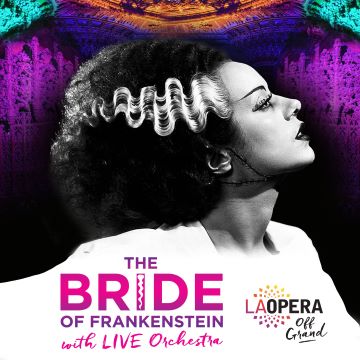STITCHED TOGETHER WITH BRILLIANCE
For Halloween this past weekend, LA Opera‘s hugely popular annual celebration of horror and live music at the breathtaking Theatre at Ace Hotel featured James Whale’s 1935 gothic horror classic The Bride of Frankenstein, accompanied by the LA Opera Orchestra. The Bride of Frankenstein with Live Orchestra was another resounding success in LA Opera’s Off-Grand series.
In the golden era of Universal Studios’ horror monster franchise, Whale revisited his classic hit, Frankenstein. The outcome of this return was the iconic sequel, The Bride of Frankenstein, widely recognized as one of cinema’s earliest examples of a sequel that is better than the original. This time around, the resurrected patchwork corpse, created by Dr. Henry Frankenstein, survives the fiery climax of the first film. Wandering the countryside, haunted by fearful villagers, he stumbles upon a blind hermit who teaches him language and reason. Meanwhile, the villainous Dr. Pretorius seeks Dr. Frankenstein’s help to craft a new life form. When Frankenstein declines, Pretorius persuades the monster himself with the promise of a companion.
The legendary Boris Karloff reprises his role as the Monster, delivering an extraordinary performance that showcases his ability to convey complex emotions and vulnerability. The Monster’s quest for companionship and understanding in a world that shuns him is both heart-wrenching and sympathetic.
Ernest Thesiger, an effete English actor, portrays Dr. Pretorius as a fey and flamboyant old man with an unrequited love for Dr. Frankenstein and a clear disdain for women. Elsa Lanchester takes on the titular role of the bride, as a ghoulish and memorable drag-queen-like figure with her striking silver-streaked hair.
Whale’s film oscillates between the refined and the vulgar, the flamboyant and the earnest, in a manner that eludes easy categorization. The film draws inspiration from German Expressionism, incorporating stark shadows and jagged tilt shots to craft the film’s distinctive visual style. The film also uses lighting, pacing, and sound design to create an atmosphere of impending dread. The film’s mise-en-scène is iconic. The gothic and expressionistic set design plays a crucial role in establishing the film’s tone and mood. We enter a world of dark castles, foreboding forests, and elaborate laboratories, all meticulously crafted to evoke a sense of otherworldly dread. The stark contrast between the opulent drawing rooms of the Frankenstein family and the nightmarish laboratory of Dr. Pretorius underscores the clash between science and morality at the heart of the narrative.
Bride of Frankenstein has earned its status as a queer classic, resonating with queer audiences since its 1935 premiere, and not just because Whale was openly gay throughout his career. Dr. Pretorius disrupts Dr. Henry Frankenstein’s wedding, proposing a partnership to create life, thereby thwarting Frankenstein’s marital consummation. As the two men venture into creating a living being together, they symbolize same-sex parental figures, with Frankenstein as the life giver and Pretorius as the nurturer. The bride herself can be interpreted as queer-coded, rejecting her intended mate, mirroring the life of men and women who were under pressure to marry and conform.
Aside from its queer subtext, the movie is also overflowing in high camp. The characters, particularly the flamboyant Dr. Pretorius, deliver their lines with exaggerated British and Mid-Atlantic accents and stilted movements eliciting laughter from the audience. Dr. Pretorius’s homunculi (miniature humanoids) are presented as bizarre and eccentric beings. Their physical appearances, such as the miniature king and queen, are intentionally comical, and their behavior is eccentric and whimsical.
The film’s score, composed by Franz Waxman, stands among the greatest film soundtracks ever created, alongside classics like King Kong, Gone with the Wind, Citizen Kane, and Vertigo. Remarkably, Waxman achieved this feat with a modest ensemble of 22 instruments, utilizing an organ to enhance the orchestra’s sound. (Enhancing a small band with keyboards is now almost standard in Broadway musical orchestrations). His score effectively captures the grotesque, lonely, and revulsive aspects of the characters, incorporating various classical idioms such as a graceful minuet, a pastoral tone, and a somber funeral march. Waxman’s use of the whole tone scale, with only six notes per octave, imparts a sense of restlessness and otherworldliness to the music, just as Debussy did in Pelléas et Mélisande, which was presented last season at LA Opera.
Taking inspiration from Wagner, Waxman created eight distinct leitmotifs, each contributing to the story, setting, and characters. Examples of these motifs include the bombastic horn fanfare for the monster, the romantic strings and harp for the bride, and a sinister theme for Dr. Pretorius.
Conducting the LA Opera Orchestra, Dr. Jenny Wong displayed a remarkable affinity for movie music, offering a spirited rendition of Waxman’s score. She synchronized the music flawlessly with the screen, guiding the orchestra through gradual tempo changes and nuanced phrasing, while also delivering powerful moments when needed. Let’s hope that Wong, a respected chorus master and operatic conductor, continues to enrich Los Angeles’ classical music scene and doesn’t leave for the Hollywood studios. Given that Wong is the newly-appointed San Francisco Symphony Chorus Director, and the Associate Artistic Director of the Los Angeles Master Chorale, that is unlikely to happen soon.
The next event in the Off-Grand series is The Book of Mountain and Sea. A fantastical world of sunbirds, demons and hairy giants is evoked in Book of Mountains and Seas, a fascinating work of vocal theater for 12 singers, two percussionists and six puppet masters. Composer/librettist Huang Ruo took his inspiration from a classic compilation of Chinese mythology《山海經》first transcribed in the fourth century B.C. Over the years, these stories have become part of Chinese written and oral history, shifted and reshaped to match contemporary times. April 10-14, 2024 at the BroadStage in Santa Monica.
The Bride of Frankenstein with Live Orchestra
LA Opera Orchestra
The Theatre at Ace Hotel in Los Angeles
reviewed on Saturday, October 28, 2023

